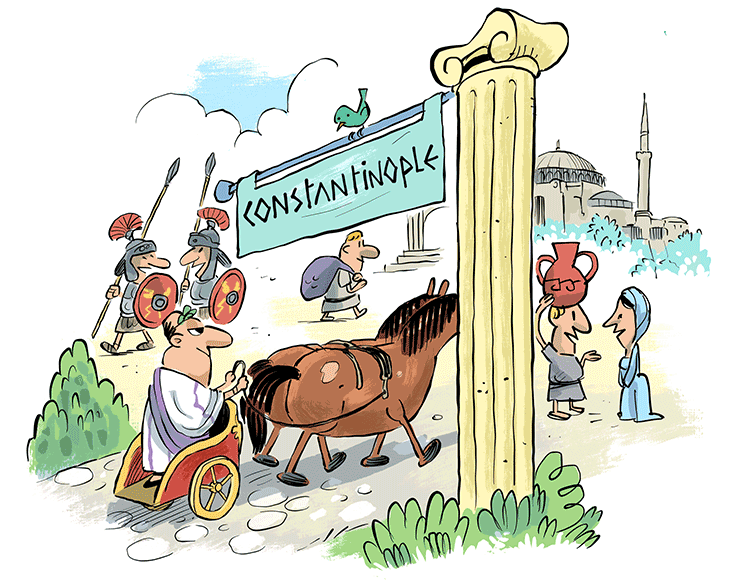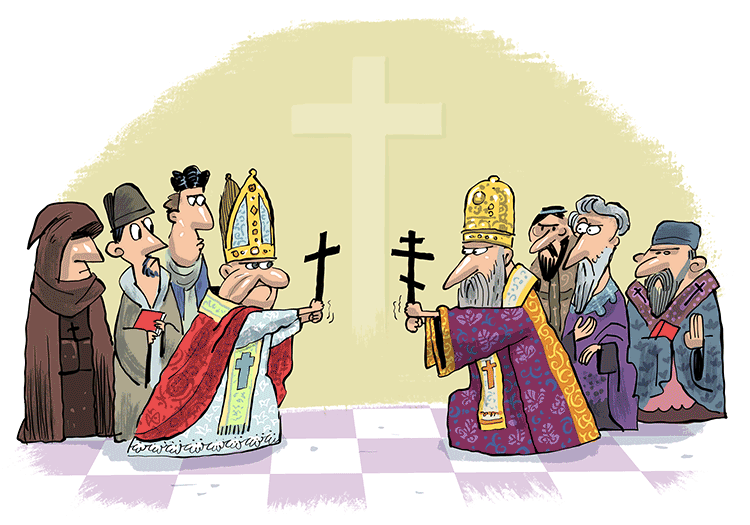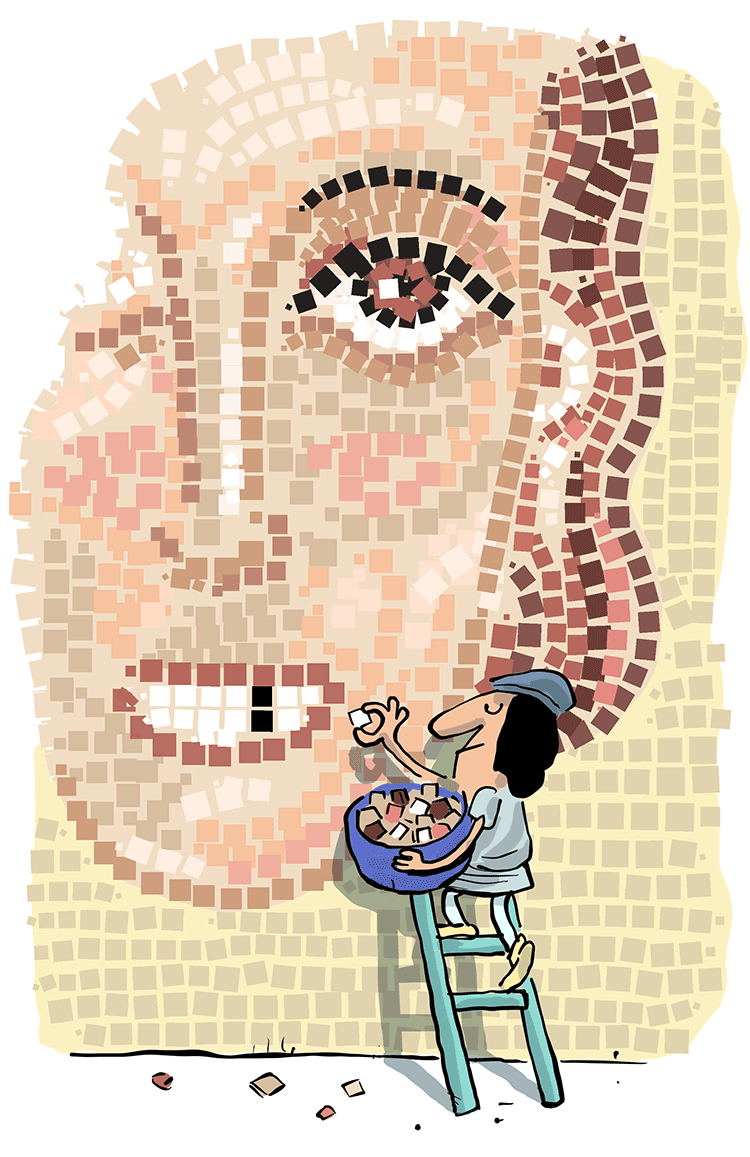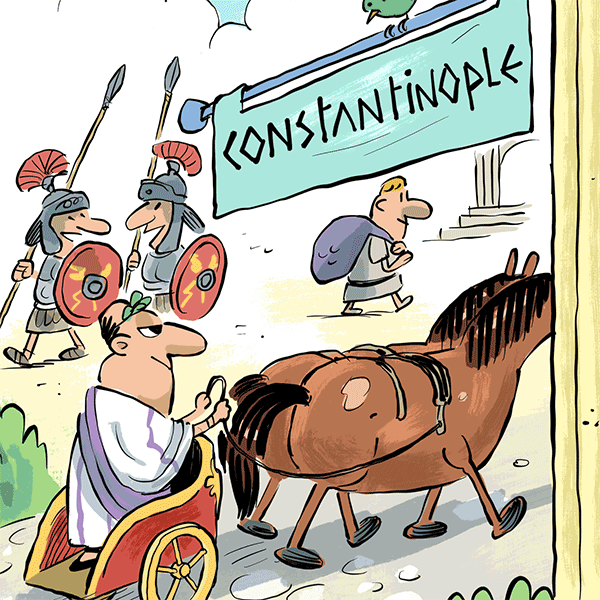One common misconception about the Middle Ages, also referred to as the Medieval Age, is that no one was in charge.
The Fall of the Western Roman empire in 476 AD opened the door for a bunch of new kingdoms. But no one ever matched Rome’s power and influence in Western Europe. Pretty much any king, noble, pope, knight, or whoever else could muster the swords was able to grab some sort of power.
This made politics quite messy.
But this picture is only accurate in western Europe. In eastern Europe, things were quite different. This is because while the Western Roman Empire fell in 476 AD, the Eastern Roman Empire continued on for more than 1,000 years.
Though much less powerful, and much smaller, than the original Roman empire, the Byzantine Empire, often called just Byzantium, kept Rome alive in so many ways.

A Continuation of the Roman Empire
One thing that’s important to note is that while we call it the Byzantine Empire, or Byzantium, these are entirely modern names.
The origin of the name is in Byzantion, the Greek name for the city where Constantinople was later built. This city is now referred to as Istanbul, the largest city in modern-day Turkey.
They just can’t quite make up their mind!
For our purposes, let’s just call it Constantinople.
The city was built in the 3rd century AD by Roman emperor Constantine II. He wasn’t vain or anything…,
But even if he was, he chose this location as an acknowledgment of the rising importance of the empire’s eastern provinces over its failing western holdings. The East was richer and more populated, so over time, Roman leaders turned their backs on western Europe and kind of just let it fall.
Talk about choosing a favorite child.
This link between the two regions is why the people living in the Byzantine Empire considered themselves Roman. They even called their empire the Roman Empire. Of course, Rome itself was no longer part of the empire, but its spirit lived on.
At this point, Rome was more of an idea than anything else.
More Greek than Roman?
Okay, so the Roman empire after 476 AD is called the Byzantine Empire, and Rome’s not a part of it. But at least the people living in this version of the empire speak Latin, the Roman language, right?
Wrong.
Most of this part of the Roman Empire, both before and after the fall of Rome, used Greek as its official language. Of course, each region and people had its own language, but Greek was often the common tongue used for law and business.
The reasons for this go back to Alexander the Great, the Greek leader who conquered most of eastern Europe and western Asia in the 4th century BC.
This is just another reminder that Rome wound up being more of an idea than anything else. Perhaps even a dream.
Rome managed to control a massive empire, and they did an amazing job at managing it. As time wore on and the empire crumbled, no one lost sight of what the Romans did.
So even though Rome was no longer part of the empire, and Latin was not really spoken by anyone living in the empire, the belief in Rome lived on, and this wound up dramatically shaping Medieval history across all of Europe.
Defending Against the East
Take a trip around Europe today and you’ll run into tons of Latin culture. A good half of the continent speaks a language that directly connects back to Latin (French, Spanish, Italian, Portuguese, Romanian, etc.) and the other languages borrow heavily from it (English to name just one).
Oh, and pretty much everyone in Europe uses the Latin alphabet.
Most European nations also use Roman-inspired laws and governments. They saw how well the Romans kept everyone together and said “hey, let’s do that too!” although on a much smaller scale.
But this strong Roman legacy was never a guarantee. Once the city of Rome fell, lots and lots of people began licking their chops and wanted to take different parts of Europe. But to do so, they’d have to go through Byzantium first.
Getting through Byzantium was sort of like trying to climb a 10,000 foot wall. It just wasn’t going to happen.
Lots of people tried, especially the Persians and the Arabs. The Arabs were the people who were native to the Arabian Peninsula. Eventually, in the 7th century AD, they unified into an Islamic kingdom that became one of the most powerful in human history.
But despite all these efforts, no one managed to get through.
And this helped keep Europe Latin.
This is neither a good nor a bad thing. Had eastern invaders broken through, things would merely look differently than they do today. But they didn’t, so Rome began to inch closer and closer to immortality.

Promoting Division in Christianity
When it comes to power in the Middle Ages, the conversation pretty much begins and ends with the Catholic Church.
In the absence of a major central authority, western Europe looked towards the Roman Catholic Church, headquartered in, you guessed it, Rome, for guidance.
However, this was not the case in Byzantium. Because a central authority did exist, i.e. the empire, religious authorities in the east were not interested in bowing down to Rome. And the leaders in Constantinople weren’t about to call Roman popes and bishops their bosses.
This, plus differences in opinion about how the faith should be practiced, forced the two different branches of Christianity further and further apart.
Many of these differences were small.
For example, the two couldn’t agree on which type of bread to use for Communion, leavened or unleavened.
Also, the Eastern Church used Greek whereas the Western Church used Latin. But while seemingly insignificant to us, these differences caused great divisions in early Christian cultures.
Then, in 1054 AD, the leaders of both Eastern and Western Christianity, the pope in Rome and the Patriarch in Constantinople, excommunicated each other.
In simpler terms, they each threw the other out of their religious parties.
This event is known as The Great Schism of 1054.
Two Churches; One Religion
Doing this officially divided the two churches, and did so pretty much forever. Efforts were made to bring the two back together, especially during and after the Crusades, but even today the two remain separate.
Differences in opinion helped drive the Schism, but ultimately power had a lot to do with it. The emperors of Byzantium believed their rule was sanctioned by God, and so it was important to them to be seen as the leaders of their church.
Answering to some guy over in Rome would undermine their power and make the empire weaker.
Therefore, even if they could have found a way to agree, it’s unlikely the Eastern Church would have ever bowed to its Roman counterpart. This split, driven in part by the connection between the Byzantine state and religion, wound up being one of the most lasting legacies of Byzantium.

A Continued Appreciation for the Arts
Another misconception many modern students have of the Middle Ages is that it was a time when art and culture suffered. Constant war, disease, and religious extremism left little room for painting, sculpting, and writing plays.
In other words, people were too busy fighting and dying of the plague to worry about painting and sculpting.
It wasn’t until the Renaissance, which means “rebirth” in Italian, that the people of Europe started heavily engaging in the arts once again. But this didn’t start until the 15th century AD, nearly 1,000 years after the fall of the Western Roman Empire.
However, this view is only true if we remain focused on western Europe.
In the east, under the Byzantine empire, the arts continued to flourish, especially during times of prosperity. During the rule of Justinian for example, great churches and other monuments went up, and a great deal of money was spent on the arts.
After the fall of the Byzantine empire in 1453, many of the artists operating in its lands had moved or began moving west. Their Muslim conquerors, the Ottoman Turks, were coming into town and were not talking about peace and togetherness.
So, as these artists moved west, and as they did, they shared their ideas and work. The people of western Europe, after a few hundred years of artistic darkness were like, “Woah! That looks like fun!” and joined in on the party.
This, plus overall improvements in quality of life, brought the arts back to Western Europe in a big way.
Modern art, although quite different, almost entirely traces its roots back to the Renaissance, which took place in large part because the Byzantines kept painting and sculpting for another 1,000 years after Rome fell.
Order in a Chaotic World
Politically speaking, the Middle Ages were a chaotic time. Numerous kings and their supporters fought for control over the lands previously held by the Western Roman Empire, making it difficult for progress to sustain itself.
However, in eastern Europe and western Asia, the opposite was true. The Byzantine Empire, centered on Constantinople in modern-day Turkey, brought order, supported the arts, and encouraged the growth of Western civilization.
In other words, it kept the spirit of Rome alive, a spirit that is still very much alive today.
Written by Matthew Jones
Illustrated by Jean Galvao
